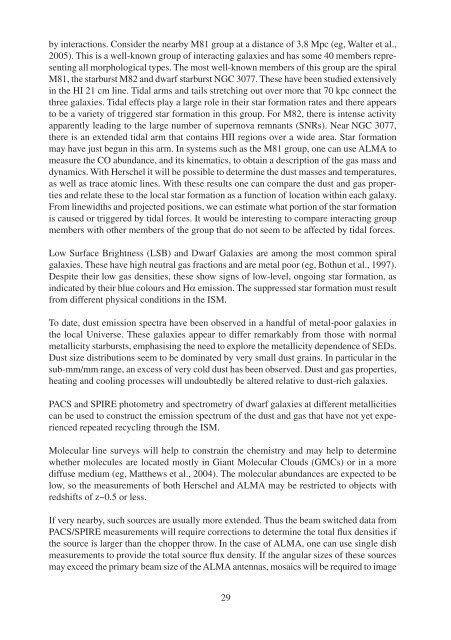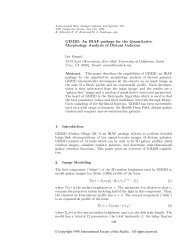4 Comparison of the ALMA and Herschel - ESO
4 Comparison of the ALMA and Herschel - ESO
4 Comparison of the ALMA and Herschel - ESO
Create successful ePaper yourself
Turn your PDF publications into a flip-book with our unique Google optimized e-Paper software.
y interactions. Consider <strong>the</strong> nearby M81 group at a distance <strong>of</strong> 3.8 Mpc (eg, Walter et al.,<br />
2005). This is a well-known group <strong>of</strong> interacting galaxies <strong>and</strong> has some 40 members representing<br />
all morphological types. The most well-known members <strong>of</strong> this group are <strong>the</strong> spiral<br />
M81, <strong>the</strong> starburst M82 <strong>and</strong> dwarf starburst NGC 3077. These have been studied extensively<br />
in <strong>the</strong> HI 21 cm line. Tidal arms <strong>and</strong> tails stretching out over more that 70 kpc connect <strong>the</strong><br />
three galaxies. Tidal effects play a large role in <strong>the</strong>ir star formation rates <strong>and</strong> <strong>the</strong>re appears<br />
to be a variety <strong>of</strong> triggered star formation in this group. For M82, <strong>the</strong>re is intense activity<br />
apparently leading to <strong>the</strong> large number <strong>of</strong> supernova remnants (SNRs). Near NGC 3077,<br />
<strong>the</strong>re is an extended tidal arm that contains HII regions over a wide area. Star formation<br />
may have just begun in this arm. In systems such as <strong>the</strong> M81 group, one can use <strong>ALMA</strong> to<br />
measure <strong>the</strong> CO abundance, <strong>and</strong> its kinematics, to obtain a description <strong>of</strong> <strong>the</strong> gas mass <strong>and</strong><br />
dynamics. With <strong>Herschel</strong> it will be possible to determine <strong>the</strong> dust masses <strong>and</strong> temperatures,<br />
as well as trace atomic lines. With <strong>the</strong>se results one can compare <strong>the</strong> dust <strong>and</strong> gas properties<br />
<strong>and</strong> relate <strong>the</strong>se to <strong>the</strong> local star formation as a function <strong>of</strong> location within each galaxy.<br />
From linewidths <strong>and</strong> projected positions, we can estimate what portion <strong>of</strong> <strong>the</strong> star formation<br />
is caused or triggered by tidal forces. It would be interesting to compare interacting group<br />
members with o<strong>the</strong>r members <strong>of</strong> <strong>the</strong> group that do not seem to be affected by tidal forces.<br />
Low Surface Brightness (LSB) <strong>and</strong> Dwarf Galaxies are among <strong>the</strong> most common spiral<br />
galaxies. These have high neutral gas fractions <strong>and</strong> are metal poor (eg, Bothun et al., 1997).<br />
Despite <strong>the</strong>ir low gas densities, <strong>the</strong>se show signs <strong>of</strong> low-level, ongoing star formation, as<br />
indicated by <strong>the</strong>ir blue colours <strong>and</strong> Hα emission. The suppressed star formation must result<br />
from different physical conditions in <strong>the</strong> ISM.<br />
To date, dust emission spectra have been observed in a h<strong>and</strong>ful <strong>of</strong> metal-poor galaxies in<br />
<strong>the</strong> local Universe. These galaxies appear to differ remarkably from those with normal<br />
metallicity starbursts, emphasising <strong>the</strong> need to explore <strong>the</strong> metallicity dependence <strong>of</strong> SEDs.<br />
Dust size distributions seem to be dominated by very small dust grains. In particular in <strong>the</strong><br />
sub-mm/mm range, an excess <strong>of</strong> very cold dust has been observed. Dust <strong>and</strong> gas properties,<br />
heating <strong>and</strong> cooling processes will undoubtedly be altered relative to dust-rich galaxies.<br />
PACS <strong>and</strong> SPIRE photometry <strong>and</strong> spectrometry <strong>of</strong> dwarf galaxies at different metallicities<br />
can be used to construct <strong>the</strong> emission spectrum <strong>of</strong> <strong>the</strong> dust <strong>and</strong> gas that have not yet experienced<br />
repeated recycling through <strong>the</strong> ISM.<br />
Molecular line surveys will help to constrain <strong>the</strong> chemistry <strong>and</strong> may help to determine<br />
whe<strong>the</strong>r molecules are located mostly in Giant Molecular Clouds (GMCs) or in a more<br />
diffuse medium (eg, Mat<strong>the</strong>ws et al., 2004). The molecular abundances are expected to be<br />
low, so <strong>the</strong> measurements <strong>of</strong> both <strong>Herschel</strong> <strong>and</strong> <strong>ALMA</strong> may be restricted to objects with<br />
redshifts <strong>of</strong> z~0.5 or less.<br />
If very nearby, such sources are usually more extended. Thus <strong>the</strong> beam switched data from<br />
PACS/SPIRE measurements will require corrections to determine <strong>the</strong> total flux densities if<br />
<strong>the</strong> source is larger than <strong>the</strong> chopper throw. In <strong>the</strong> case <strong>of</strong> <strong>ALMA</strong>, one can use single dish<br />
measurements to provide <strong>the</strong> total source flux density. If <strong>the</strong> angular sizes <strong>of</strong> <strong>the</strong>se sources<br />
may exceed <strong>the</strong> primary beam size <strong>of</strong> <strong>the</strong> <strong>ALMA</strong> antennas, mosaics will be required to image<br />
29




